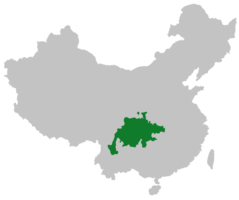Chengdu-Chongqing dialect
| Chengdu-Chongqing dialect | |
|---|---|
| 成渝话 | |
| Pronunciation | [tsʰən˨˩y˨˩xua˨˨˦] |
| Native to | China |
| Region | Sichuan, Chongqing, Hubei and Shaanxi |
Native speakers | About 90 million |
|
Sino-Tibetan
| |
| Language codes | |
| ISO 639-3 | – |
| Glottolog |
chen1267 Chengdu Mandarin[1] |
 Chengdu-Chongqing is the largest deep-green area. | |
Chengdu-Chongqing dialect or Cheng–Yu (Chinese: 成渝; pinyin: Chéng-Yú; Sichuanese Pinyin: Cen2yu2, local pronunciation: [tsʰən˨˩y˨˩]) is the most widely used branch of Southwestern Mandarin, with about 90 million speakers. It is named after Chengdu, the capital city of Sichuan, and Chongqing, which was split from Sichuan in 1997. It is spoken mainly in northern and eastern Sichuan, the northeastern part of the Chengdu Plain, several cities or counties in southwestern Sichuan (Panzhihua, Dechang, Yanyuan, Huili and Ningnan), southern Shaanxi and western Hubei.[2][3]
This uniform dialect is formed after the great migration movement in Ming and Qing dynasty, and is greatly influenced by the Chinese varieties the immgrants spoke Mandarin from Hubei, Xiang and Gan. So it keeps fewer characteristics of Sichuan's original Ba-Shu Chinese than other Sichuanese dialects, such as Minjiang dialect.
References
- ↑ Hammarström, Harald; Forkel, Robert; Haspelmath, Martin, eds. (2017). "Chengdu Mandarin". Glottolog 3.0. Jena, Germany: Max Planck Institute for the Science of Human History.
- ↑ 李蓝(2009年第1期),《西南官话的分区(稿)》,方言
- ↑ Wurm, Stephen Adolphe; Li, Rong; Baumann, Theo; Lee, Mei W. (1987). Language Atlas of China. Longman. Map B6. ISBN 978-962-359-085-3.
